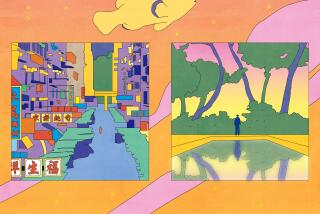China’s cinematic revolution
Ever since the 1920s, Chinese film history has been grouped into large, monolithic blocks, as imposing as the Great Wall. There’s the First Generation of silent-movie pioneers, the Fifth Generation of “post-Maoist humanists,” the Sixth Generation that sprang from the cultural wreckage of Tiananmen Square, and so on -- coinages used both in and outside China.
But it may be time to retire such static terminology, judging from the dozen highly individualistic, genre-mashing works that make up the series “Between Disorder and Unexpected Pleasures: Tales From the New Chinese Cinema.”
The program, which opens April 6 at REDCAT in downtown Los Angeles, offers a sense of how Chinese independent filmmakers are stretching the limits of the art form while overcoming undernourished budgets and steering around -- or perhaps soaring over -- the heads of hard-eyed government censors. Spurred by the advent of cheaper digital technology, these young filmmakers are stylistically daring and increasingly fearless in addressing, or at least alluding to, taboo topics such as homosexuality (in Hao Jie’s “Single Man,” for example) and the heavy social costs of China’s breakneck dash toward modernity.
What’s more, this new generation comprises not only several filmmakers who didn’t train at the state-run Beijing Film Academy but also a number of painters- and writers-turned-directors who are bringing fresh visual and narrative approaches to their camerawork. “I call it this sort of flowering of many voices,” says Cheng-Sim Lim, a film scholar who co-curated “Between Disorder.” “You have this breaking up of this very unitary view of Chinese film.”
China’s commercial film market lately has become one of the world’s fastest growing. The nation’s rapidly expanding middle class is spending more of its discretionary income on entertainment. Dozens of new Western-style multiplexes are springing up. Hollywood and Hong Kong investors are casting lustful looks at a potential audience of more than 1 billion people.
The nation’s independent film scene is a far different matter economically but no less dynamic in creative terms. Alternately exhilarating and alarming, slyly humorous and poetically melancholy, the series’ films collectively present a prismatic view of a society in which individual artistic expression is rising but entire categories of people -- displaced farmers stuck in the feudal era, the masses of urban poor -- have been rendered expendable, as their communities and ways of life get steamrolled by China’s aggressively globalizing political economy.
The series depicts a country in which gleaming new corporate high-rises loom like giant terra-cotta warriors over tattered but teeming residential areas. “You cannot walk in a major Chinese city, or even a small Chinese city, without walking in a field of rubble,” says Berenice Reynaud the series’ other curator and a film scholar who’s on the faculty at California Institute of the Arts. “It’s ‘destroy, destroy, destroy.’”
Although none of the films in “Between Disorder” is likely to turn up in the flashy new theater chains of Shanghai or Guangzhou, independent Chinese movies now appear regularly on the international film festival circuit. They’ve also become easier to see inside China.
“You have film clubs, cafes, you have also a number of websites where you can download independent video for free, [and] you have a lot of little film societies,” says Reynaud. She and Lim conceived the series about 15 years ago, under the auspices of the UCLA Film & Television Archive, and have been programming it ever since.
Reynaud says she acquires many of the films during annual Hong Kong trips from which she returns loaded down with as many as 150 DVDs. Because they work outside Beijing’s state-run film bureaucracy, these filmmakers are generally tolerated, if viewed with glancing suspicion. “They have the benefit of being ignored, basically, by the authorities,” Lim says.
Although the REDCAT portion of the series wraps up Saturday night, films also will be screened this month at the Hammer Museum and the Egyptian Theatre, and April 11 through 14 at the Pomona College Museum of Art/Media Studies. The Echo Park Film Center will host an April 11 showing of “Night of an Era” (Zaijian Wutuobang), Sheng Zhimin’s 2009 documentary ode to the Chinese independent rock movement of the 1980s and the onstage antics and backstage lives of some of its performers.
Beginning April 29, the bulk of the series will be re-screened at the Museum of the Moving Image in New York, whose chief curator, David Schwartz, shares Reynaud and Lim’s bullishness toward China’s independent film explosion. “It sort of reminds me of the early days of American independent cinema when, because 16mm cameras were available, people were able to go out and make their own movies,” Schwartz says. “People who are looking at world cinema right now are looking to China.”
The uncompromisingly independent visions on display in “Between Disorder” leave plenty of room for beauty, wit, formal innovation and the other “unexpected pleasures” that the series title refers to. For example, Zhao Ye’s poignant tone poem “Jalainur” posits a deceptively minimalist storyline about Old Zhu, a steam-engine train conductor whose imminent retirement means saying goodbye to his apprentice and close friend Li Zhizhong.
The movie’s beautifully composed shots of smoke-belching steam engines heaving like fire-breathing dragons, and human figures silhouetted by moody night skies, wrests lyricism from the machine-ravaged landscapes of Inner Mongolia. Shruggingly indifferent to their bosses’ party-line platitudes about the noble mission of industrial nation-building, the men forge a separate peace with one another from nearly wordless exchanges. “Jalainur” brings to mind the terse poetry of European Modernist writers such as Samuel Beckett, while its metaphorical landscapes evoke Antonioni’s “Zabriskie Point.”
“The sort of strategies that Modernism has used to fracture narrative, the sort of self-reflexive techniques, I think you can see in a lot of these films,” Lim says.
Among the most startlingly original movies is “Oxhide II,” a sequel by the young female director Liu Jiayin to her stunning, self-financed “Oxhide I” (2004), which she shot in Cinemascope in her parents’ 50-square-meter apartment/kitchen/workshop in southern Beijing, where the family scratches out a living by making purses. Casting her real-life parents as themselves and deploying a single, stationary camera, the writer-director combines carefully choreographed body movements and seemingly incidental but actually scripted dialogue in tightly framed shots, producing a claustrophobic and harrowing, yet disarmingly humorous narrative of a family’s inner tensions.
The banal rituals of daily life take on surprising significance as Liu reveals her skill as a miniaturist master and her deep empathy toward characters struggling to break free of physical and social confines. Reynaud compares the way the “Oxhide” films unfold to the method of spreading out and reading a classical Chinese scroll painting. “What they borrow from the scroll is the absence of a vanishing point, the absence of a master gaze and, very importantly, the use of negative space,” she says.
(Liu Jiayin will be present at REDCAT’s Friday, April 8 screening of “Oxhide II” and take part in a Q&A session after a 4 p.m. Friday screening of “Oxhide I” on the Cal Arts campus in Valencia.)
“Oxhide,” “Jalainur” and several other series films underscore a tendency among independent Chinese filmmakers to mix fiction with documentary. Those strategies are skillfully deployed in Jia Zhangke’s “I Wish I Knew” (2010), which suggests how historical memory in China, including cinematic memory, is among the collateral damage wrought by Communist Party-administered capitalist progress. In this unclassifiable movie, by arguably China’s most significant filmmaker of the past decade, contemporary images of economically booming Shanghai are refracted through the gauzy filter of older films -- some, like the classic “A Spring in a Small Town” (1948), dating from when roiling Shanghai was the country’s movie-industry capital -- and interviews with directors, cast and crew members of those earlier movies.
In between these sequences, a beautiful woman wanders phantom-like through Shanghai’s rain-swept streets. Gradually, the film’s multiple layers of commentary unite to create what Reynaud describes as “this very complex texture of movies about Shanghai by people who are not living there but have some sort of relation to Shanghai through memory or exile.”
Traditional vérité documentary also has a place in the series. In “A Disappearance Foretold” (2008), filmmakers Olivier Meys and Zhang Yaxuan relate the systematic destruction of a poor, run-down but still vital Beijing neighborhood to make way for new projects tied to the 2008 Olympic Games. The movie observes ordinary Chinese citizens voicing unusually candid opinions (some cynical, others resigned) about their society and venting their fury at bureaucrats.
Unlike the legions of foreign journalists who parachuted in to cover the Olympics, then flew home, these filmmakers gained their subjects’ trust by spending months witnessing their hardships, Reynaud says. “They have the sense of patience.”
Liu Jiayin shows a similar patience with her long, single-take shots of a tiny family’s valiant tragi-comic struggles, as do the quietly observed, unrushed moments of “Jalainur.” Patience indeed may be a prerequisite for filmmakers hoping to make lasting works while modern China rushes by.
More to Read
Only good movies
Get the Indie Focus newsletter, Mark Olsen's weekly guide to the world of cinema.
You may occasionally receive promotional content from the Los Angeles Times.











